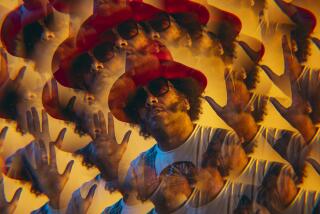Flirting With Controversy
Screenwriter Gina Wendkos, whose film âCoyote Ugly,â about the rowdy, female-run nightspot of the same name, knows the ins and outs of the New York bar scene. During the 1980s, when she staged elaborate performance-art pieces at places like La MaMa and the Performance Garage, Wendkos worked in bars and clubs to make ends meet.
âIâve hat-checked, Iâve bartended, Iâve danced. Thereâs really nothing I havenât done except take my clothes off,â Wendkos recalled.
Another thing Wendkos knows is that not everyone will embrace the in-your-face, strut-your-stuff sexuality portrayed in the movie, which took in $17.3 million at the box office in its opening weekend.
âI expect critics will accuse me of exploiting women, Iâve heard a lot of that,â Wendkos said last week in an interview at her home in the Hollywood Hills. âBut I donât think I exploit women at all--I think I empower them. The girl that owns the bar, Lil [portrayed by Maria Bello], sheâs so full of force, personal force. And all the girls are sexy, theyâre hot, but theyâre not objects of sexuality. They are sexuality.â
Just what kind of sexy are we talking about here?
In the movie, the bartenders, hot babes dressed in tight leather pants and clingy halter tops, periodically jump up on the bar and whip the mostly male crowd into a frenzy with their provocative dance moves--a sort of MTV bump-and-grind version of country line dancing--and douse each other with water and liquor.
Furthermore, the girls, or coyotes as theyâre affectionately referred to, are encouraged to accept drinks from customers (tequila or whiskey shots, straight up) and are told to appear âavailableâ--but not actually be available--all while on the job. And when the new girl on staff, a wide-eyed Jersey girl (Piper Perabo) demurs from taking part in the action, the boss, a tough-talking broad, promptly fires her on the spot.
So are the antics showcased in the film examples of the types of questionable working conditions that exploit women? Or does the movie simply communicate a new spirit of assertive, if not downright aggressive, female sexuality like the kind portrayed on HBOâs brash and raunchy sitcom âSex and the Cityâ?
Wendkos claims itâs the latter. And she disputes the argument that itâs offensive for a woman to make a living by flaunting her sexuality.
âThese women are not fragile,â said Wendkos. âThatâs why I hate political correctness, because it strips women of their power. Like [women are] gentle creatures that need all this protection. I think PC is ruinous for women.â
More than a few movie reviewers called âCoyote Uglyâ a 2000 version of the 1980s zeitgeist film âFlashdance.â (Not coincidentally, both films were produced by Jerry Bruckheimer, for whom Wendkos is developing TV and movie projects.)
âTheyâre similar in that both movies are about a girl chasing her dream against the odds and finding her voice and her talent through exhibitionist behavior. But [in âFlashdanceâ] the sexuality was much more feminine. âCoyoteâ has a more in-your-face sexuality.â
But ironically, for all the attention the film and its sexy ad campaign are getting, âCoyote Uglyâ is actually a PG-13-rated Cinderella story (if you can imagine Cinderella in tight, low-slung, snakeskin pants) and thereâs nary a foul word uttered or a bare breast in sight. And itâs released under Disneyâs Touchstone banner no less.
âIâm thrilled itâs PG-13,â said Wendkos. âMy 13-year-old niece is going with all her friends. Iâm proud of it; I donât think itâs sleazy at all.â
Wendkos, a petite brunet woman who looks like she could be one of the âCoyote Uglyâ girls herself, considers her own experience as a taxi-dancer (the kind of rent-a-girl-for-a-dance job made famous by Tina Turner in the song and video âPrivate Dancerâ) more demeaning than what the coyote girls do.
âI danced at a very strange bar, a mob bar, called Blue Parrot,â Wendkos remembered. âThe customer would buy a drink for 6 or 7 bucks, and a dance would be [an additional] 10. But I only worked on tips, the house got the rest. In fact, I had to pay the house to work there.
âI was an object. It was like, âHereâs 20 bucks, Iâll dance with you, youâre my object.â The coyote girls own their sexuality.â
It seems a fine line but for Wendkos the distinction is control. âAre you behaving this way to be an ornament to a man or are you behaving this way because youâre full of self-choice?â
And that goes for the characters of the drama sheâs developing for Showtime: high-priced call girls.
âOne call girl said to me, and in a way I agree with her, âI know plenty of girls in this town that have married really rich Beverly Hills guys--and not for love--and theyâre the bigger whores. Because I might do a trick two times a day but the rest of the day is mine. These other women are whores 24-7.â â
The pilot, âExtreme Behavior,â which is being developed under the auspices of Bruckheimerâs television production arm, is about âhuman behavior,â according to the hugely successful producer. âWhat makes that world work?â
But whether youâre a coyote or a high-class prostitute, the emphasis is undoubtedly on youth, beauty and sexiness. Some question whether thatâs the right image for Hollywood to portray in this post-feminist world.
For Wendkos itâs not so much a case of how it should be as how it is. âItâs like any other business. Beauty is the thing that opens the door. Thatâs as true in waitressing and call-girling as it is in anything short of true science. People gravitate toward beauty.â
And the bar stuff in the movie is very much the real deal, noted Wendkos, who spent time at the real Coyote Ugly (on 9th Street and 1st Avenue) while writing the script. In fact, on a recent weekend, said Wendkos, the bartenders made $800 apiece in tips in one night.
*
Wendkos, who is single, is unpretentious and a study in contrasts. Born to expatriate-artist parents in Florence, Italy, she and her family returned to the States when her father took a job as the resident portrait painter at the Fountainbleu Hotel in Miami Beach. After her father died when Wendkos was in junior high school, the family moved to New York City and Wendkos went on to get her bachelorâs and masterâs degrees in fine art at the Maryland Institute College of Art.
But Wendkos now disavows the art world. âI donât like painting. I hardly like art,â she said. âI have a bad feeling about art. I donât like modern art. I hate it in fact. I think itâs a scam.â
Similarly, Wendkos, who was a recipient of a National Endowment for the Arts grant for original playwriting for her work âDinosaursâ and was the darling of the Los Angeles theater scene in the late 1980s and early 1990s, had never even seen or read a play before a boyfriend dragged her to see âTorch Song Trilogyâ in the 1980s in New York.
And though she is the sole writer given screen credit for âCoyote Ugly,â she readily admits that writers Kevin Smith, Todd Graff and Jeff Nathanson all contributed to âCoyote.â
âJerry typically brings in a lot of writers,â she says without a trace of ego. âThatâs his technique and I think it really works.â
For her next feature film, âThe Princess Diaries,â Wendkos is shelving the sex stuff. âPrincess,â which is based on Meg Cabotâs forthcoming young-adult novel, is a modern-day fairy tale about an awkward New York teen who finds out sheâs the princess of a small European principality. Garry Marshall of âPretty Womanâ fame is directing the movie for Disney.
Other projects include âMaggieâs Men,â an original screenplay sheâs writing for Bruckheimer Productions, and âSheâll Pay,â a one-hour drama sheâs developing for British television.
In the meantime, Wendkos is taking her âCoyoteâ success, and criticism, in stride. âItâs not a pretentious movie,â she said. âIt doesnât have huge ambitions. Itâs a small movie about a small girl from a small town with big dreams. I love it.â
More to Read
Only good movies
Get the Indie Focus newsletter, Mark Olsen's weekly guide to the world of cinema.
You may occasionally receive promotional content from the Los Angeles Times.










